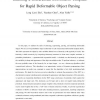Free Online Productivity Tools
i2Speak
i2Symbol
i2OCR
iTex2Img
iWeb2Print
iWeb2Shot
i2Type
iPdf2Split
iPdf2Merge
i2Bopomofo
i2Arabic
i2Style
i2Image
i2PDF
iLatex2Rtf
Sci2ools
PAMI
2010
2010
Learning a Hierarchical Deformable Template for Rapid Deformable Object Parsing
In this paper, we address the tasks of detecting, segmenting, parsing, and matching deformable objects. We use a novel probabilistic object model that we call a hierarchical deformable template (HDT). The HDT represents the object by state variables defined over a hierarchy (with typically 5 levels). The hierarchy is built recursively by composing elementary structures to form more complex structures. A probability distribution – a parameterized exponential model – is defined over the hierarchy to quantify the variability in shape and appearance of the object at multiple scales. To perform inference – to estimate the most probable states of the hierarchy for an input image – we use a bottom-up algorithm called compositional inference. This algorithm is an approximate version of dynamic programming where approximations are made (e.g., pruning) to ensure that the algorithm is fast while maintaining high performance. We adapt the structure-perceptron algorithm to estimate the p...
| Added | 29 Jan 2011 |
| Updated | 29 Jan 2011 |
| Type | Journal |
| Year | 2010 |
| Where | PAMI |
| Authors | Long Zhu, Yuanhao Chen, Alan L. Yuille |
Comments (0)

